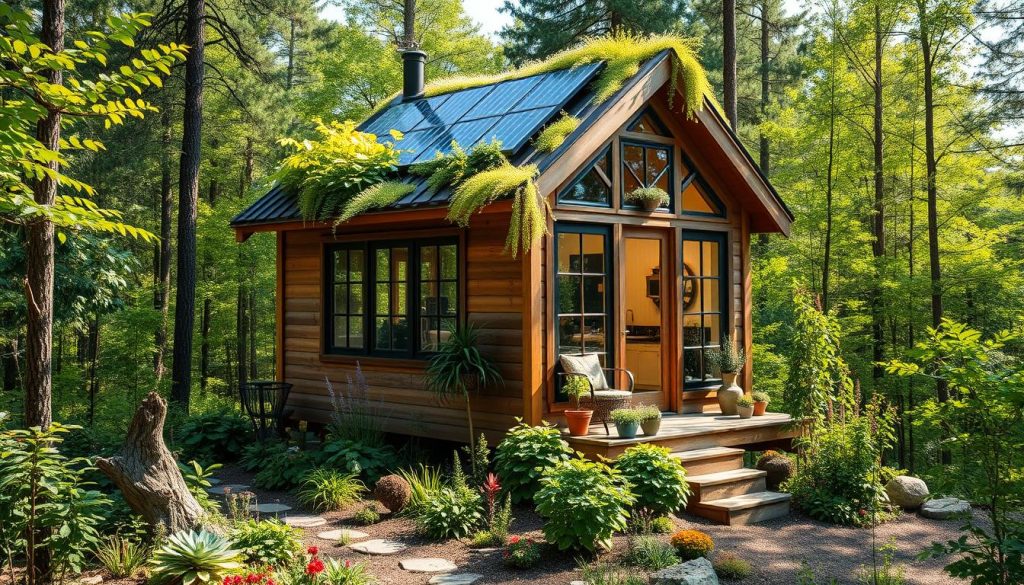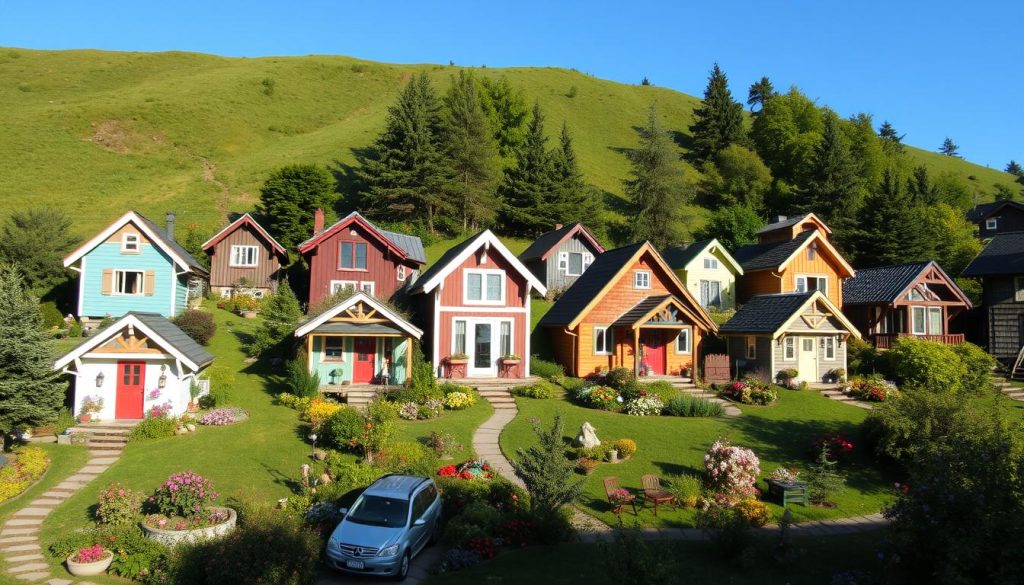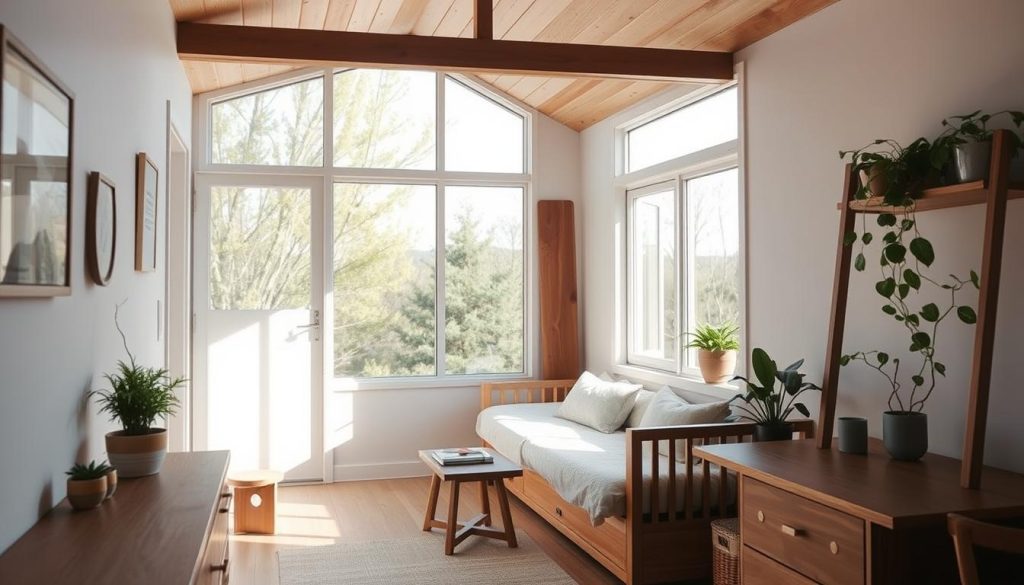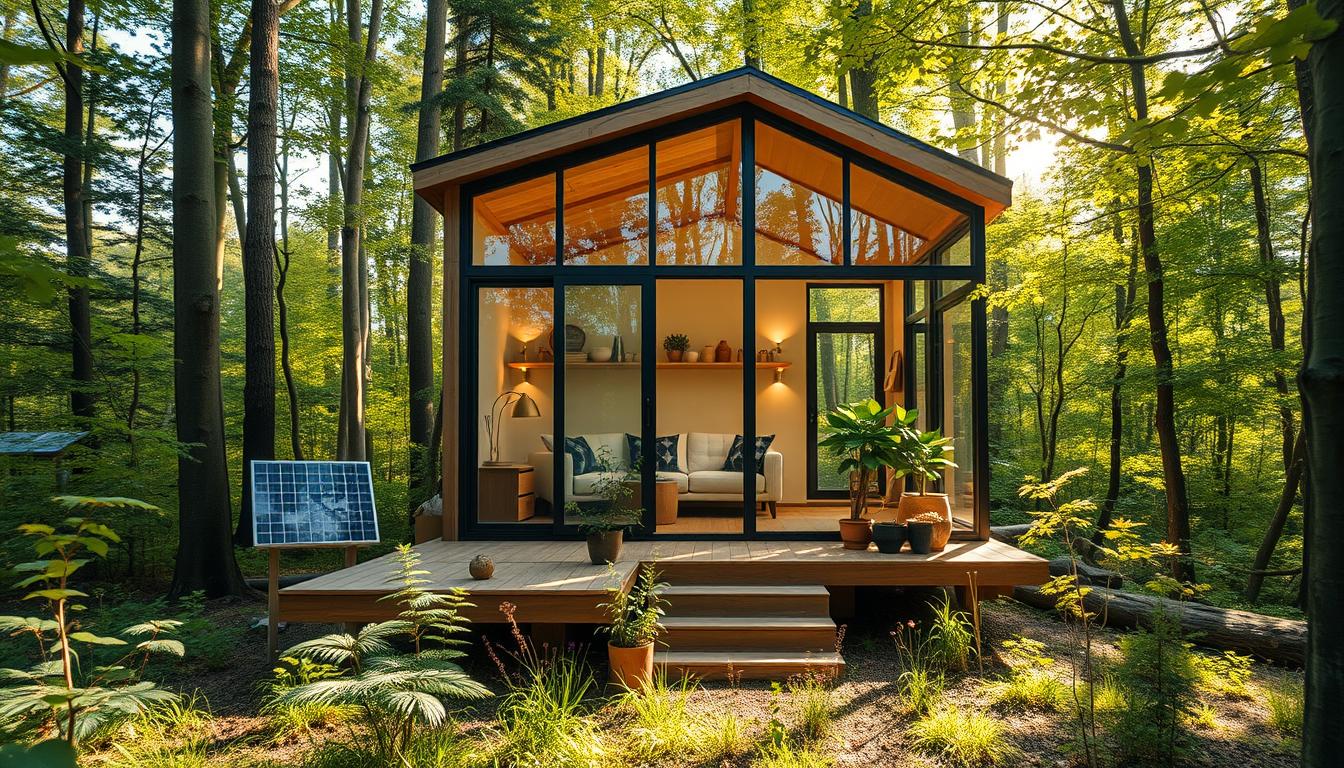In today’s fast-paced world, more Americans are choosing to live smaller. The tiny home movement is all about downsizing and living simply. It offers financial freedom, environmental benefits, and a simpler life. People are picking homes under 400 square feet, changing what the American dream means.
The tiny home movement is more than a trend. It’s a shift in what we value. People want to live more sustainably, and tiny homes are key. They use less energy and resources, showing us how to live more mindfully.
Living in a tiny home also means saving money. It helps cut down on huge mortgage payments, utility bills, and upkeep. This freedom lets people focus on their passions, save, or invest in other important things.
The tiny home movement is growing fast. It’s not just a trend; it’s a lifestyle that appeals to those wanting to simplify. I’m proud to be part of it and can’t wait to share my story with you.
What Is the Tiny Home Movement?
The tiny home movement has become very popular. It attracts people looking for a different way to live, away from big houses. It shows that living small can be beautiful and practical.
Defining Tiny Living
The tiny home movement is all about simplicity. Tiny homes are small, ranging from 100 to 400 square feet. They focus on being efficient and simple, helping people value what’s important.
Key Characteristics of Tiny Homes
- Efficient and Multifunctional Design: Tiny homes use every inch wisely. They have special furniture and storage to save space.
- Eco-Friendly Construction: People building tiny homes often use green materials. They also add features to save energy.
- Variety of Styles: Tiny homes come in many styles. You can find everything from cozy cabins to modern homes.
The tiny home movement is more than just homes. It’s a choice for a simpler life. It offers freedom and a chance to live in harmony with nature.
The Benefits of Embracing Tiny Living

Choosing a tiny home can open up a world of benefits. It leads to a more sustainable lifestyle. You get financial freedom and a smaller environmental impact.
Financial Freedom and Savings
One big advantage of tiny living is saving money. You pay less for a mortgage or rent and use less energy. This means you can spend more on experiences and personal growth.
Environmental Impact
Tiny homes are better for the planet. They use less energy and materials. This reduces your carbon footprint and helps the environment.
Simplified Lifestyle
Living tiny means a simpler life. You have fewer things and focus on what’s important. This leads to happiness and well-being.
Living tiny is more than just a home. It’s a way to live more sustainably and find freedom. You get financial stability and a deeper connection to the world.
My Journey Into Tiny Home Living
The tiny home movement has always fascinated me. I started thinking about downsizing and living simply. The idea of saving money, being kinder to the planet, and living more simply was very appealing.
Initial Inspiration
I wanted to escape the usual home life. I dreamed of a life with fewer things and less upkeep. Seeing my friends happy in their tiny homes made me even more excited.
Challenges I Faced
Switching to tiny home living was tough. It was hard to adjust to less space and rethink my life. I also had to figure out legal and practical things like zoning and moving around.
Finding the Right Tiny Home
After a lot of searching, I found the perfect tiny home. It had to be functional, mobile, and match my style. Finding it was thrilling and rewarding, making the move in even more special.
Tiny Home Design and Space Optimization

Designing a tiny home needs a sharp eye for making the most of every inch. I’ve learned that to live well in a small space, every square foot must be used wisely.
Creative Storage Solutions
Finding room for all your stuff in a tiny home can be tough. But, with some creativity, even the tiniest spots can become useful storage areas. I’ve used built-in shelves, hidden spots, and furniture that does double duty to keep my home tidy.
Functional Floor Plans
Creating a good floor plan is vital for small living. I’ve tried out different layouts to make sure my tiny home is easy to move around in. By placing key areas like the kitchen, bedroom, and living room just right, I’ve made my home feel spacious and welcoming.
Personalizing My Space
Functionality is important, but I’ve also focused on adding personal touches. I’ve chosen decor and built custom features that show off my style and personality. This way, my tiny home is not just functional but also a cozy and inspiring place I’m proud to live in.
Living in a Tiny Home: Daily Life

Living in a tiny home offers both rewards and challenges. Downsizing and simplifying daily life can be transformative. I’ve seen it change lives for the better.
Adapting to Limited Space
At first, tiny home living might seem daunting. It’s hard to think about fitting all your stuff into a small space. But, with creativity and a willingness to let go, it’s easier than you think.
I’ve found ways to use every inch of my home. Clever storage and thoughtful decor make a big difference. It’s all about using space wisely.
Community and Connection
One of the best things about tiny home living is the community. People in these neighborhoods often support and care for each other. It’s a feeling of belonging and shared purpose.
This connection has brought me a lot of joy. It shows that living simply can also mean living more deeply with others.
Overcoming Common Misconceptions
Many people still think tiny homes are cramped or uncomfortable. But, a well-designed tiny home can be just as cozy as a big one. It’s all about focusing on what’s truly important.
By living simply, I’ve found happiness in my tiny home. It’s a lifestyle that truly works.
Legal Aspects of Tiny Home Living
Exploring the legal side of tiny home living can be tricky. But knowing the key points can make your journey smoother. We’ll look at zoning laws, building codes, and financing options. These are crucial for enjoying the tiny home lifestyle.
Zoning Laws and Regulations
When you live in a tiny home, you must follow local zoning laws and building codes. These rules can change a lot depending on where you are. It’s important to check what your area requires.
Some places have special rules for mobile homes or tiny houses. Others might have stricter rules. Knowing these differences is key.
It’s also important to know the difference between stationary and mobile tiny homes. Stationary homes follow the same rules as regular houses. Mobile homes might be seen as RVs or personal property.
Tiny Home Financing Options
Getting a loan for a tiny home can be different from a regular mortgage. But, there are ways to finance your tiny home. Traditional lenders offer personal loans or tiny home loans.
Some builders also have their own financing or leasing plans. This can help you get the money you need. It’s a good idea to look at different options to find what works best for you.
The Future of the Tiny Home Movement
The tiny home movement is growing fast, with new trends and innovations on the horizon. These changes promise a greener and more independent future for tiny home living. With better solar panels and water systems, tiny home owners can live more off the grid and harm the environment less.
Trends and Innovations
Architects and designers are making tiny homes more advanced and eco-friendly. They’re using new materials and smart designs. Soon, tiny homes will be more customizable and efficient than ever before. These advancements will help tiny homes become a big part of our sustainable future.
The Growing Community
The tiny home community is getting bigger, with more people joining in. This growth brings together experts and enthusiasts, sharing ideas and support. As the community grows, it’s making a big impact on how we plan cities and build homes. It’s a positive sign for the future of tiny homes and solving housing and environmental issues.

